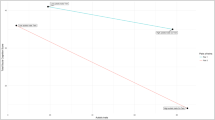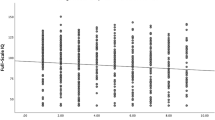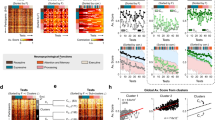Abstract
Little evidence supports that siblings with autism exhibit the same behaviors; however, some findings suggest that level of functioning shows familial aggregation. We tested this notion among multiplex families participating with the Autism Genetic Resource Exchange (AGRE) Consortium, using scores on the Peabody Picture Vocabulary Test—Third Edition (N = 204 families), the Ravens Colored Progressive Matrices (N = 226 families), and the Vineland Adaptive Behavior Scales (N = 348 families). Intraclass Correlation Coefficients revealed that siblings with autism/autism spectrum disorders (ASD) were more similar on measures of verbal and nonverbal IQ and adaptive functioning than were unrelated children with autism/ASD. Preliminary twin correlations indicated strong genetic effects for some skill domains and the influence of shared environmental factors for others.
Similar content being viewed by others
Notes
This information was not provided for the motor-skills domain.
The AGRE Consortium includes: Dan Geschwind, M.D., Ph.D., UCLA, Los Angeles, CA, USA; Maja Bucan, Ph.D., University of Pennsylvania, Philadelphia, PA, USA; W. Ted Brown, M.D., Ph.D., F.A.C.M.G., N.Y.S. Institute for Basic Research in Developmental Disabilities, Long Island, NY, USA; Rita M. Cantor, Ph.D., UCLA School of Medicine, Los Angeles, CA, USA; John N. Constantino, M.D., Washington University School of Medicine, St. Louis, MO, USA; T. Conrad Gilliam, Ph.D., University of Chicago, Chicago, IL, USA; Clara Lajonchere, Ph.D, Cure Autism Now, Los Angeles, CA; David H. Ledbetter, Ph.D., Emory University, Atlanta, GA; Christa Lese-Martin, Ph.D., Emory University, Atlanta, GA, USA; Janet Miller, J.D., Ph.D., Cure Autism Now, Los Angeles, CA; Stanley F. Nelson, M.D., UCLA School of Medicine, Los Angeles, CA, USA; Gerard D. Schellenberg, Ph.D., University of Washington, Seattle, WA; Carol A. Samango-Sprouse, Ed.D., George Washington University, Washington, D.C.; Sarah Spence, M.D., Ph.D., UCLA, Los Angeles, CA, USA; Matthew State, M.D., Ph.D., Yale University , New Haven, CT, USA; Rudolph E. Tanzi, Ph.D., Massachusetts General Hospital, Boston, MA, USA.
References
Autism Genetic Resource Exchange Consortium. (2006). AGRE affected status categories. Retrieved December 12, 2006, from http://agre.org/agrecatalog/algorithm.cfm
Bailey, A., Le Couteur, A., Gottesman, I., Bolton, P., Simonoff, E., Yuzda, E., & Rutter, M. (1995). Autism as a strongly genetic disorder: Evidence from a British twin study. Psychological Medicine, 25, 63–77.
Bibby, P., Eikeseth, S., Martin, N. T., Mudford, O. C., & Reeves, D. (2002). Progress and outcomes for children with autism receiving parent-managed intensive interventions. Research in Developmental Disabilities, 23(1), 81–104.
Boyle, M. H., & Willms, J. D. (2001). Multilevel modelling of hierarchical data in developmental studies. Journal of Child Psychology and Psychiatry, 42(1), 141–162.
Carter, A. S., Volkmar, F. R., Sparrow, S. S., Wang, J., Lord, C., Dawson, G., Fombonne, E., Loveland, K., Mesibov, G., & Schopler, E. (1998). The Vineland Adaptive Behavior Scales: Supplementary norms for individuals with autism. Journal of Autism and Developmental Disorders, 28(4), 287–302.
Cuccaro, M. L., Shao, Y., Bass, M. P., Abramson, R. K., Ravan, S. A., Wright, H. H., Wolpert, C. M., Donnelly, S. L., & Pericak-Vance, M. A. (2003). Behavioral comparisons in autistic individuals from multiplex and singleton families. Journal of Autism and Developmental Disorders, 33(1), 87–91.
Dunn, L. M., & Dunn, L. M. (1997). Peabody Picture Vocabulary Tests (3rd ed.). Circle Pines: American Guidance Service.
Eikeseth, S., Smith, T., Jahr, E., & Eldevik, S. (2002). Intensive behavioral treatment at school for 4- to 7-year-old children with autism. A 1-year comparison controlled study. Behavior Modification, 26(1), 49–68.
Folstein, S., & Rutter, M. (1977). Infantile autism: A genetic study of 21 twin pairs. Journal of Child Psychology and Psychiatry, 18, 297–321.
Goin-Kochel, R. P., Myers, B. J., & Mackintosh, V. H. (2006). Parental reports on the use of treatments and therapies for children with autism spectrum disorders. Research in Autism Spectrum Disorders, doi:10.1016/j.rasd.2006.08.006
Goldstein, H. (2002). Communication intervention for children with autism: A review of treatment efficacy. Journal of Autism and Developmental Disorders, 32(5), 373–396.
Hox, J. (2002). Multilevel analysis: Techniques and applications. New Jersey: Lawrence Erlbaum Associates.
Kolevzon, A., Smith, C. J., Schmeidler, J., Buxbaum, J. D., & Silverman, J. M. (2004). Familial symptom domains in monozygotic siblings with autism. American Journal of Medical Genetics. Part B Neuropsychiatric Genetics, 129(1), 76–81.
Kraijer, D. (2000). Review of adaptive behavior studies in mentally retarded persons with autism/pervasive developmental disorder. Journal of Autism and Developmental Disorders, 30(1), 39–47.
Le Couteur, A., Bailey, A., Goode, S., Pickles, A., Robertson, S., Gottesman, I., et al. (1996). A broader phenotype of autism: The clinical spectrum in twins. Journal of Child Psychology and Psychiatry, 37(7), 785–801.
Levine, M. N. (1986). Leiter International Performance Scale: A handbook “Arthur Adaptation of the Leiter International Performance Scale: A Handbook”. Los Angeles: Western Psychological Services.
Lord, C., Risi, S., Lambrecht, L., Cook, E. H., Jr., Leventhal, B. L., DiLavore, P. C., et al. (2000). The autism diagnostic observation schedule-generic: A standard measure of social and communication deficits associated with the spectrum of autism. Journal of Autism and Developmental Disorders, 30(3), 205–223.
Lord, C., Rutter, M., & Le Couteur, A. (1994). Autism Diagnostic Interview-Revised: A revised version of a diagnostic interview for caregivers of individuals with possible pervasive developmental disorders. Journal of Autism and Developmental Disorders, 24(5), 659–685.
MacLean, J. E., Szatmari, P., Jones, M. B., Bryson, S. E., Mahoney, W. J., Bartolucci, G., et al. (1999). Familial factors influence level of functioning in pervasive developmental disorder. Journal of the American Academy of Child and Adolescent Psychiatry, 38(6), 746–753.
Mazefsky, C. A., Goin-Kochel, R. P., Riley, B. P., Maes, H. H., & The Autism Genetic Resource Exchange Consortium (2007). Genetic and environmental influences on symptom domains in twins and siblings with autism. Research in Autism Spectrum Disorders. doi: 10.1016/j.rasd.2007.08.002
Mottron, L. (2004). Matching strategies in cognitive research with individuals with high-functioning autism: Current practices, instrument biases, and recommendations. Journal of Autism and Developmental Disorders, 34(1), 19–27.
Newsom, C., & Hovanitz, C. A. (1997). Autistic disorder. In E. J. Mash & L. G. Terdal (Eds.), Assessment of childhood disorders (3rd ed., pp. 408–452). New York: Guilford.
Newsom, C., & Rincover, A. (1989). Autism. In E. J. Mash & R. A. Barkley (Eds.), Treatment of childhood disorders (pp. 286–346). New York: Guilford.
Raven, J. C. (1947, 1995). Colored progressive matrices: Sets I and II. Oxford: Oxford Psychologists Press Ltd.
Schopler, E., Short, A., & Mesibov, G. (1989). Relation of behavioral treatment to “normal functioning”: Comment on Lovaas. Journal of Consulting and Clinical Psychology, 57(1), 162–164.
Silverman, J. M., Smith, C. J., Schmeidler, J., Hollander, E., Lawlor, B. A., Fitzgerald, M., Buxbaum, J. D., Delaney, K., Galvin, P., & Autism Genetic Research Exchange Consortium. (2002). Symptom domains in autism and related conditions: Evidence for familiality. American Journal of Medical Genetics. Part B Neuropsychiatric Genetics, 114, 64–73.
Sparrow, S. S., Balla, D. A., & Cicchetti, D. V. (1984). Vineland adaptive behavior scales. Circle Pines: American Guidance Service.
Spiker, D., Lotspeich, L., Kraemer, H. C., Hallmayer, J., McMahon, W., Petersen, P. B., et al. (1994). Genetics of autism: Characteristics of affected and unaffected children from 37 multiplex families. American Journal of Medical Genetics, 54(1), 27–35.
Szatmari, P. (1999). Heterogeneity and the genetics of autism. Journal of Psychiatry & Neuroscience, 24(2), 159–165.
Szatmari, P., Jones, M. B., Holden, J., Bryson, S., Mahoney, W., Tuff, L., MacLean, J., White, B., Bartolucci, G., Schutz, C., Robinson, P., & Hoult, L. (1996). High phenotypic correlations among siblings with autism and pervasive developmental disorders. American Journal of Medical Genetics. Part B Neuropsychiatric Genetics, 67, 354–360.
Wechsler, D. (1967). Manual for the Wechsler preschool and primary scale of intelligence. New York: The Psychological Corporation.
Wechsler, D. (1974). Manual for the Wechsler intelligence scale for children--revised. New York: The Psychological Corporation.
Wechsler, D. (1981). WAIS-R manual Wechsler Adult Intelligence Scale-Revised. New York: The Psychological Corporation. Harcourt Brace Jovanovich Publishers.
Acknowledgments
We gratefully acknowledge the resources provided by the Autism Genetic Resource Exchange (AGRE) ConsortiumFootnote 2 and the participating AGRE families. The Autism Genetic Resource Exchange is a program of Cure Autism Now and is supported, in part, by grant MH64547 from the National Institute of Mental Health to Daniel H. Geschwind (PI). Dr. Goin-Kochel was supported by an NIH Institutional Training Grant, T32NS-43124 (PI JW Swann); Dr. Mazefsky was supported by a National Research Service Award from the NIH, T32MH-20030 (PI MC Neale). We would also like to thank Eric Duku at the Offord Centre for Child Studies for his assistance with statistical analyses.
Author information
Authors and Affiliations
Corresponding author
Rights and permissions
About this article
Cite this article
Goin-Kochel, R.P., Mazefsky, C.A. & Riley, B.P. Level of Functioning in Autism Spectrum Disorders: Phenotypic Congruence Among Affected Siblings. J Autism Dev Disord 38, 1019–1027 (2008). https://doi.org/10.1007/s10803-007-0476-z
Received:
Accepted:
Published:
Issue Date:
DOI: https://doi.org/10.1007/s10803-007-0476-z




